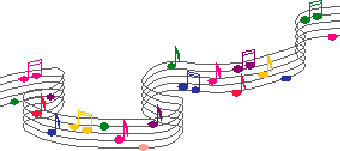Mozart (1756-91)
MOZART'S SYMPHONY No 40 in G MINOR
1st Movement Molto Allegro
Section Description Key and Cadence Exposition 1st Subject
1st subject stated by vlns accompanied by alternating harmonic 3rds, 4ths and 6ths played by vlas.
Flute, oboes and bassoons join at dominant pedal of g minor section in forte dynamics.
2nd statement of 1st subject starts in repetition for first 4 bars with added oboes and bassoons.
G minor
Bb major
Perfect Cad
Transition Transition theme played by vlns, accompanied by alternating 3rds and 4ths played by bassoons, vlas and lower strings. Three repetitions of ascending f minor scale played by the vlns. Dominant pedal in Bb major played by bassoons and lower strings.
One bar pause
Bb major
f minor
Bb major
2nd Subject Vlns begin the fragmentary 2nd subject for 1 1/2 bar and subject is taken over by Clarinet and bassoon I for another 1 1/2 bar. Vlns finishes the 2nd subject with a descending chromatic scale. 2nd statement of 2nd subject begins an octave higher played by the flute, clarinets and bassoons. Reversal of roles. Vlns take over the subject followed by the flute, clarinets and bassoons finishing the 2nd subject.
Closing material of 2nd subject (minor 2nd motif) played in repetition.
Bb major Perfect Cadence
Ab major Bb major Perfect Cad
Codetta Ascending chromatic closing theme played by vlns followed by dotted rhythms. Derivation of 1st subject motif first played by clarinets and imitated by bassoons and later stated by 1st vlns accompanied by tutti in forte. Reversal of roles. Bassoons state 1st subject derivation imitated by clarinets. Section ends with tutti in extension of cadence.
Bb major
Perfect Cad
Development Begins with chord I in g minor - vii7d of a minor and descending chromatic scale by flute, oboes and bassoons. 4 bar derivation of 1st subject stated by vlns and accompanied by vlas with alternating harmonic 3rds, 4ths and 6ths. Long held chords played by bassoons. Bassoons and lower strings state derived 1st subject accompanied by broken chordal staccato figure in forte. Vlns imitate the derived 1st subject while the bassoons and lower strings imitate the broken chordal motif. The harmony moves in circle of 5ths. Ends in dominant pedal played by bassoons and lower strings.
Shortened 1st subject motif first played by 1st vlns in imitation with flute and clarinets accompanied by long held note in bassoons. Passage in high register. Vlns II and Vlas join in with syncopated descending figure answered by flute, clarinets and bassoons. Vlns I and lower strings in descending sequence playing 1st subject motif.
Motif further shortened to titi ta first played by vlns and vlas, answered by lower strings in inversion. (Forte) Woodwinds play broken chordal figure. Horns play dominant pedal. Flute take over the three note motif imitated by clarinets with bassoons playing the dominant pedal.
G minor f# minor
e minor a minor d minor g minor C major F major Bb major d minor
g minor
Recapitulation 1st Subject
1st subject stated by vlns accompanied by alternating harmonic 3rds, 4ths and 6ths played by vlas.
Flute, oboes and bassoons join at dominant pedal of g minor section in forte dynamics.
2nd statement of 1st subject starts in repetition for first 4 bars with added oboes and bassoons.
g minor
Eb major
Perfect Cad
Transition Transition theme played by vlns, accompanied by alternating 3rds and 4ths played by bassoons, vlas and lower strings. Transition theme taken over by bassoons and lower strings while accompanied by ascending broken chordal and descending scalic figure in the vlns in descending sequence. 1st vlns play modified transition theme, juxtaposed with original transition theme. Harmony moving in circle of 5ths.
Transition theme stated by vlns with alternating 3rds and 4ths played by bassoons and lower strings.
Three repetitions of ascending d minor scale played by the vlns. Dominant pedal in g minor played by bassoons and lower strings.
One bar pause
Eb major f minor Perfect Cad
f minor Bb major Eb major Bb major
c minor
g minor
2nd Subject Vlns begin the fragmentary 2nd subject for 1 1/2 bar and subject is taken over by flute, oboes and bassoon I for another 1 1/2 bar. Vlns finishes the 2nd subject with a descending chromatic scale. 2nd statement of 2nd subject begins an octave higher played by the flute, oboes and bassoons. Reversal of roles. Vlns take over the subject followed by the flute, oboes and bassoons finishing the 2nd subject.
Closing material of 2nd subject (minor 2nd motif) played in repetition.
Extension of section. Flute, 1st oboe, 1st clarinet, 1st bassoon introduced descending diminished ascending broken chordal motif in varied sequence.
g minor
Eb major Bb major c minor d minor g minor Perfect Cad
Coda Ascending chromatic closing theme played by vlns a 3rd lower followed by dotted rhythms. Derivation of 1st subject motif first played by clarinets and imitated by bassoons, also joined in by the flute. 1st vlns state the longer derivation accompanied by tutti in forte. Reversal of roles. Bassoons state 1st subject derivation imitated by clarinets and later also the flute. 1st vlns state a longer derivation accompanied by tutti in forte.
Section ends with tutti in extension by the use of chromatic dotted rhythms. This is followed by a longer fragment of 1st subject motif played first by 2nd vlns, then imitated by 1st vlns. Flute, clarinets and bassoons then take over the motif, ending the movement with the extension of Perfect Cadence similar to the Exposition.
g minor


 Back to History of Music
Back to History of Music To Homepage
To Homepage